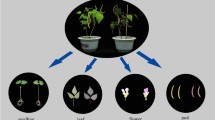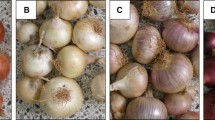Abstract
A new locus conditioning a pink trait in onions was identified. Unusual pink onions were found in haploid populations induced from an F1 hybrid between yellow and dark red parents and in F3 populations originating from the same cross. Segregation ratios of red to pink in F2, backcross, and F3 populations indicated that this pink trait is determined by a single recessive locus. RT-PCR was carried out to look for any differential expression of anthocyanin synthesis genes between dark red and pink F3 lines. The transcript level of anthocyanidin synthase (ANS) was significantly reduced in the pink line. To determine whether this reduced transcription is caused by other regulatory factors or by mutations in the ANS gene itself, ANS gene sequences from both dark red and pink F3 lines were compared to detect any polymorphisms. Polymorphisms were identified, and subsequently utilized as molecular markers for the selection of ANS alleles. Absolute co-segregation of the pink allele and the ANS allele from the pink line was observed in parents, F1 and F3 populations. These results indicate that reduced transcription of the ANS gene caused by mutations in a cis -acting element is likely to result in the pink trait in onions.





Similar content being viewed by others
References
Alfenito MR, Souer E, Goodman CD, Buell R, Mol J, Koes R, Walbot V (1998) Functional complementation of anthocyanin sequestration in the vacuole by widely divergent glutathione S-transferases. Plant Cell 10:1135–1149
Bastianetto S, Quirion R (2002) Natural extracts as possible protective agents of brain aging. Neurobiol Aging 5687:1–7
Bharti A, Khurana J (2003) Molecular characterization of transparent testa (tt) mutants of Arabidopsis thaliana (ecotype Estland) impaired in flavonoid biosynthesis pathway. Plant Sci 165:1321–1332
Bohanec B, Jakse M, Ihan A, Javornik B (1995) Studies of gynogenesis in onion (Allium cepa L.): induction procedures and genetic analysis of regenerants. Plant Sci 104:215–224
Boss P, Davies C, Robinson S (1996) Expression of anthocyanin biosynthesis pathway genes in red and white grape. Plant Mol Biol 32:565–569
Braca A, Sortino C, Politi M, Morelli I, Mendez J (2002) Antioxidant activity of flavonoids from Licania licaniaeflora. J Ethnopharmacol 79:379–381
Campion B, Alloni C (1990) Induction of haploid plants in onion (Allium cepa L.) by in vitro culture of unpollinated ovules. Plant Cell Tiss Org Cult 20:1–6
Campion B, Azzimonti MT, Vicini E, Schiavi M, Falavigna A (1992) Advances in haploid plant induction in onion (Allium cepa L.) through in vitro gynogenesis. Plant Sci 86:97–104
Clarke AE, Jones HA, Little TM (1944) Inheritance of bulb color in the onion. Genetics 29:569–575
Cook NC, Samman S (1996) Flavonoids—chemistry, metabolism, cardioprotective effects, and dietary sources. Nutr Biochem 7:66–76
Davis GN, El-Shafie MW (1967) Inheritance of bulb color in the onion (Allium cepa L.). Hilgardia 38:607–622
Dooner HK, Robbins TP, Jorgensen RA (1991) Genetic and developmental control of anthocyanin biosynthesis. Annu Rev Genet 25:173–199
Falconer DS, Mackay TFC (1996) Introduction to quantitative genetics. Longman, London, pp 1–47
Fossen T, Andersen OM, Ovstedal DO, Pedersen AT, Raknes A (1996) Characteristic anthocyanin pattern from onions and other Allium spp. J Food Sci 61:703–706
Henikoff S, Henikoff G, Alford J, Pietrokovski S (1995) Automated construction and graphical presentation of protein blocks from unaligned sequences, Gene-COMBIS. Gene 163:GC17–26
Hollman P, Katan M (1997) Absorption, metabolism and health effects of dietary flavonoids in man. Biomed Pharmacother 51:305–310
Holton TA, Cornish EC (1995) Genetics and biochemistry of anthocyanin biosynthesis. Plant Cell 7:1070–1083
Keli S, Hertog M, Feskens E, Kromhout D (1996) Flavonoids, antioxidant vitamins and risk of stroke. The Zutphen study. Arch Int Med 156:637–642
Kim S, Binzel M, Yoo K, Park S, Pike L (2004) Inactivation of DFR (Dihydroflavonol 4-reductase) gene transcription results in blockage of anthocyanin production in yellow onions (Allium cepa). Mol Breeding, in press
Knekt P, Jarvinen R, Reunanen A, Maatela J (1996) Flavonoid intake and coronary mortality in Finland: a cohort study. Brit Med J 312:478–481
Kobayashi T, Nakata T, Kuzumaki T (2002) Effect of flavonoids on cell cycle progression in prostate cancer cells. Cancer Lett 176:17–23
Larsen ES, Alfenito MR, Briggs WR, Walbot V (2003) A carnation anthocyanin mutant is complemented by the glutathione S-transferases encoded by maize Bz2 and petunia An9. Plant Cell Rep 21:900–904
Li J, Ou-Lee T, Raba R, Amundson R, Last R (1993) Arabidopsis flavonoid mutants are hypersensitive to UV-B irradiation. Plant Cell 5:171–179
Marrs KA, Alfenito MR, Lloyd AM, Walbot V (1995) A glutathione S-transferase involved in vacuolar transfer encoded by the maize gene Bronze-2. Nature 375:397–400
Martin C, Prescott A, Mackay S, Bartlett J, Vrijlandt E (1991) Control of anthocyanin biosynthesis in flowers of Antirrhinum majus. Plant J 1:523–532
Menssen A, Höhmann S, Martin W, Schable PS, Peterson PA, Saedler H, Gierl A (1990) The En/Spm transposable element of Zea mays contains splice sites at the termini generating a novel intron from a dSpm element in the A2 gene. EMBO J 9:3051–3058
Mol J, Jenkins G, Schafer E, Weiss D (1996) Signal perception, transduction, and gene expression involved in anthocyanin biosynthesis. Crit Rev Plant Sci 15:525–557
Muren RC (1989) Haploid plant induction from unpollinated ovaries in onion. Hortscience 24:833–834
Pike L (1986) Onion breeding. In: Basset MJ (ed) Breeding vegetable crops. AVI Publishing, Westport, Conn., pp 161–176
Reiman GH (1931) Genetic factors for pigmentation in the onion and their relation to disease resistance. J Agr Res 42:251–278
Rose M, Schultz R, Henikoff G, Pietrokovski S, McCallum M, Henikoff S (1998) Consensus-degenerate hybrid oligonucleotide primers for amplification of distantly-related sequences. Nucleic Acids Res 26:1628–1635
Shirley BW (1996) Flavonoid biosynthesis: ‘new’ functions for an ‘old’ pathway. Trends Plant Sci 1:377–382
Wilmouth R, Turnbull J, Welford R, Clifton I, Prescott A, Schofield C (2002) Structure and mechanism of anthocyanidin synthase from Arabidopsis thaliana. Structure 10:93–103
Yamazaki M, Makita Y, Springob K, Saito K (2003) Regulatory mechanisms for anthocyanin biosynthesis in chemotypes of Perilla frutescens var. crispa. Biochem Eng J 14:191-197
Zeback R, Dressler K, Hess D (1989) Flavonoid compounds from pollen and stigma of Petunia hybrida: inducers of the vir region of the Agrobacterium tumefaciens Ti plasmid. Plant Sci 62:83–91
Acknowledgements
The authors thank members of Vegetable & Fruit Improvement Center for their dedicated support of this research. This work was supported by member contributions to the Vegetable & Fruit Improvement Center and by a U.S. Department of Agriculture grant (CSREES 2001-34402-10543, “Designing Foods for Health”).
Author information
Authors and Affiliations
Corresponding author
Additional information
Communicated by R. Hagemann
Rights and permissions
About this article
Cite this article
Kim, S., Binzel, M.L., Yoo, K.S. et al. Pink (P), a new locus responsible for a pink trait in onions (Allium cepa) resulting from natural mutations of anthocyanidin synthase. Mol Genet Genomics 272, 18–27 (2004). https://doi.org/10.1007/s00438-004-1041-5
Received:
Accepted:
Published:
Issue Date:
DOI: https://doi.org/10.1007/s00438-004-1041-5




